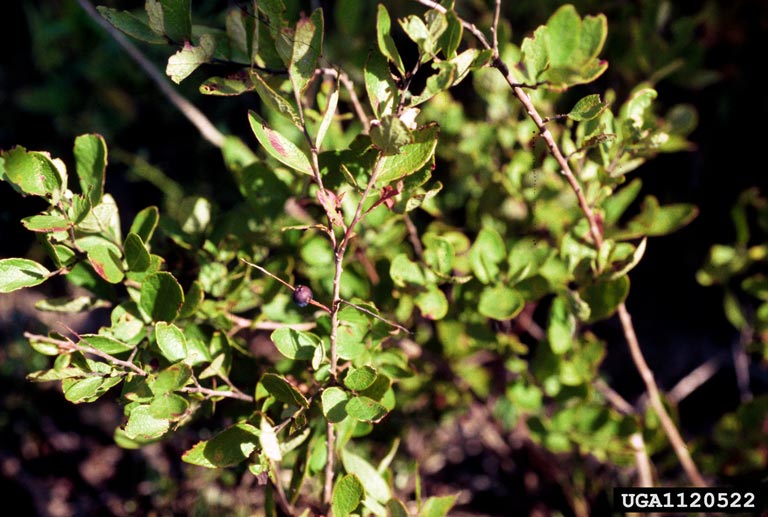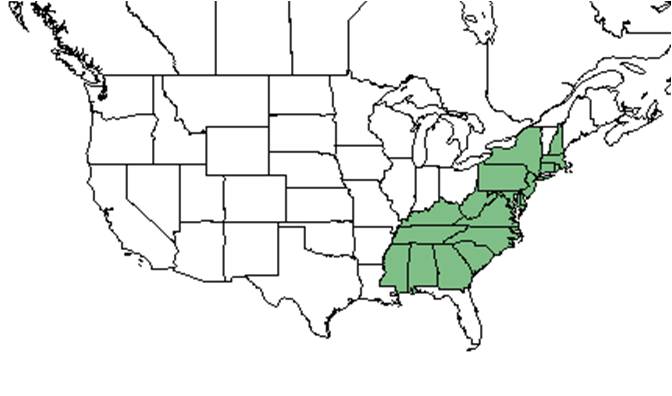Gaylussacia frondosa
| Gaylussacia frondosa | |
|---|---|

| |
| Photo by Dwight K. Lauer, Auburn University, Bugwood.org | |
| Scientific classification | |
| Kingdom: | Plantae |
| Division: | Tracheophyta- Vascular plants |
| Class: | Magnoliopsida - Dicotyledons |
| Order: | Ericales |
| Family: | Ericaceae |
| Genus: | Gaylussacia |
| Species: | G. frondosa |
| Binomial name | |
| Gaylussacia frondosa (L.)Torr. & A. Gray | |

| |
| Natural range of Gaylussacia frondosa from USDA NRCS Plants Database. | |
Common names: blue huckleberry, dangleberry
Contents
Taxonomic notes
Synonyms: Decachaena frondosa (Linnaeus) Torrey & Gray; Gaylussacia frondosa var. frondosa[1]
Varieties: none[1]
Description
A description of Gaylussacia frondosa is provided in The Flora of North America.
Distribution
This is primarily a southeastern Coastal Plain species - it's range extends from southern New Hampshire to southern South Carolina. Less commonly, it's found inland in western New York and Pennsylvania, Virginia, and South Carolina.[1]
Ecology
Habitat
G. frondosa has been found in low pine woods, slash pine-gallberry-saw palmetto flatwoods, bogs, upland slopes, and mountaintops.[2] It is also found in disturbed areas including along roadsides and annually burned pineland.[2] Gaylussacia frondosa is restricted to native groundcover with a statistical affinity in upland pinelands of South Georgia. [3] G. frondosa became absent in response to soil disturbance by military training in west Georgia. It has shown resistance to regrowth in reestablished longleaf pine habitat that was disturbed by these activities.[4] It was also found to decrease in occurrence or become absent in response to soil disturbance by agriculture in southwest Georgia. It has additionally shown resistance to regrowth in reestablished pineland that was disturbed by agricultural practices.[3]
Gaylussacia frondosa var. nana is frequent and abundant in the Upper Panhandle Savannas community type as described in Carr et al. (2010).[5]
Associated species: Serenoa repens, Kalmia, Waccinium, and Azalea.[2][6]
Phenology
G. frondosa has been observed to flower in April.[7]
Seed dispersal
This species is thought to be dispersed by consumption by vertebrates. [8]
Conservation, cultivation, and restoration
G. frondosa should avoid soil disturbance by military training and agriculture to conserve its presence in pine communities.[3][4]
Cultural use
The fruit can be used to make a sweet and spicy dessert.[9]
Photo Gallery
References and notes
- ↑ 1.0 1.1 1.2 Weakley, A.S. 2020. Flora of the Southeastern United States. Edition of 20 October 2020. University of North Carolina at Chapel Hill, Chapel Hill, North Carolina.
- ↑ 2.0 2.1 2.2 Florida State University Herbarium Database. URL: http://herbarium.bio.fsu.edu. Last accessed: May 2021. Collectors:R. Komarek, Sidney McDaniel, R. A. Norris, Bert Pittman, Kathy Boyle, and Herrick Brown. States and counties: Florida: Okaloosa. Georgia: Clinch, Thomas. South Carolina: Chesterfield.
- ↑ 3.0 3.1 3.2 Ostertag, T.E., and K.M. Robertson. 2007. A comparison of native versus old-field vegetation in upland pinelands managed with frequent fire, South Georgia, USA. Pages 109–120 in R.E. Masters and K.E.M. Galley (eds.). Proceedings of the 23rd Tall Timbers Fire Ecology Conference: Fire in Grassland and Shrubland Ecosystems.
- ↑ 4.0 4.1 Dale, V.H., S.C. Beyeler, and B. Jackson. (2002). Understory vegetation indicators of anthropogenic disturbance in longleaf pine forests at Fort Benning, Georgia, USA. Ecological Indicators 1(3):155-170.
- ↑ Carr, S.C., K.M. Robertson, and R.K. Peet. 2010. A vegetation classification of fire-dependent pinelands of Florida. Castanea 75:153-189.
- ↑ Emory University Herbarium accessed using Southeastern Regional Network of Expertise and Collections (SERNEC) data portal. URL: http://sernecportal.org/portal/collections/index.php Last accessed: June 2021. Collectors: R.E. Shanks. States and Counties: Virginia: Giles.
- ↑ Nelson, G. PanFlora: Plant data for the eastern United States with emphasis on the Southeastern Coastal Plains, Florida, and the Florida Panhandle. www.gilnelson.com/PanFlora/ Accessed: 9 DEC 2016
- ↑ Kirkman, L. Katherine. Unpublished database of seed dispersal mode of plants found in Coastal Plain longleaf pine-grasslands of the Jones Ecological Research Center, Georgia.
- ↑ Fernald, et al. 1958. Edible Plants of Eastern North America. Harper and Row Publishers, New York.